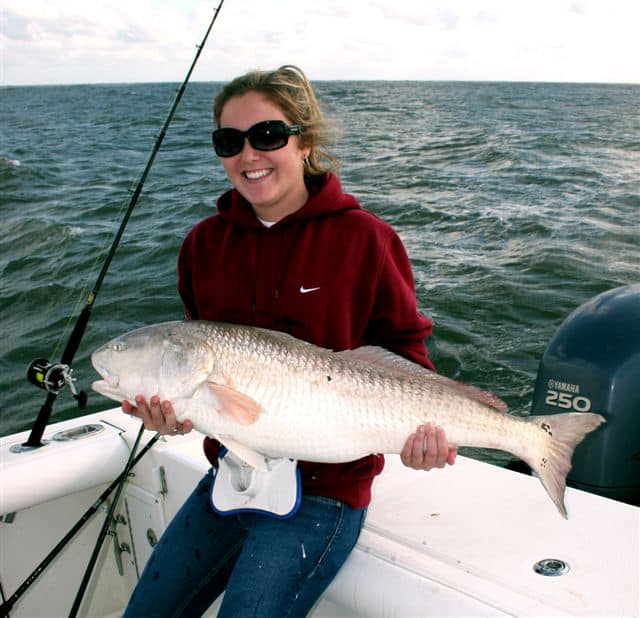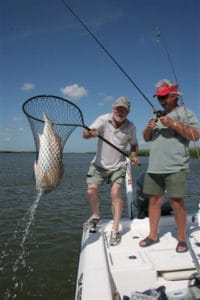by Bob McNally
Huge fall-run red drum are available throughout the southeast United State. From North Carolina to Texas, redfish push into rivers, inlets and coastal bays for spawning, and huge reds to 70 pounds are caught by anglers fishing from shore, piers, docks, kayaks, boats and the surf.
Anglers in the know understand that if there’s a sure thing in the Coastal South during September, October and November, it’s that redfish action will be the best of the year. And while reds of all sizes are available, spawning-run giants weighing 25 to 50 pounds are caught almost daily in Virginia, North & South Carolina, Georgia, Florida, Alabama, Mississippi, Louisiana and Texas.
Smaller keeper, or slot-size, redfish in the 3 to 12 pound range offer great autumn fishing in these coastal states, too, chiefly in tide-water rivers, back bays, bayous, creeks and sounds.
But for consistent big fish, those spawning-run behemoths that live offshore most of the, it’s the major Atlantic and Gulf Coast inlets, passes and river mouths leading to open water where action is best.
Virtually all oversize reds are released unharmed. Fish over about 15 pounds have course flesh that is not particularly good to eat. State laws also require most big spawning reds to be released unharmed. Alabama and Mississippi allow harvesting just one giant red over the slot limit, but conservation-minded anglers release all the 15+ pounders they catch. And they catch a lot of them!
Virginia’s barrier islands surf fishing offers superb heavyweight red drum action in October. Fish are in the surf feeding on crabs, menhaden and mullet as water temperature cools. Excellent fishing can be found in the surf off Smith, Myrtle, Ship Shoal, Wreck, Cobb, Hog and Parramore islands. All are uninhabited, and allow fishing, except at night.
Captain Buddy Vaughn (www.easternshoreadventures.com, phone (757-615-7723) leads surf anglers to prime fishing by running his boat in the sheltered, western inshore bays of the barrier islands. He then beaches his boat or anchors near the islands, unloads surf tackle into carts, and walks to the eastern side of islands where surf fishing for giant red drum is red hot. Fish in the 30-pound range are common, and redfish to 50 pounds are possible.
North Carolina’s Pamlico Sound has dozens of shoals that attract spawning and post-spawning monster red drum, called channel bass locally. The entire western side of the sound and the “backsides” of Ocracoke and Hatteras inlets abound with shoals where redfish feed. Among the hot spots are Royal Island Shoals, Brant Island Shoals and Swan Island Shoals.
The tail end of the spawn runs through October, when reds pull out of the Neuse and Pamlico rivers, bulk up feeding around Pamlico Sound shoals, and begin their migration back out of the sound through Hatteras and Ocracoke inlets. Great fishing can be had in the sound and inlets, with 50- to 60-fish days not uncommon for a boat of good anglers.
Pamlico Sound reds are caught by anglers anchored near shoal water, soaking cut mullet baits on bottom. Mullet is preferred over crabs because reds are less likely to take cut baits deep, which is important for easy de-hooking and releasing giant, spawning-size drum. Chumming with cut mullet draws drum but often isn’t necessary when multiple baits are cast around a fishing boat.
Captain George Beckwith (phone 252-671-3474; www.pamlicoguide.com) met his wife Anna while doing redfish biological work on Pamlico Sound. Both are marine biologists. George has been a redfish guide on the sound since 1994, grew up fishing reds in the area and is a good source for local information.
The area near Georgetown has five South Carolina rivers draining into the Atlantic Ocean. This creates a perfect spawning and nursery ground for red drum, and October is the height of the fishing action for them.
The Georgetown jetties, the shoal system off Cape Romain, the mouths of the North Santee and South Santee rivers, and the Bull Island bar system hold big schools of giant spawning red drum. Inshore, huge schools of smaller redfish can be found in Winyah Bay, North Inlet and Bulls Bay.
Georgetown charter captain Tommy Scarborough doesn’t begin fishing until he locates thick schools of menhaden or mullet. Often bait schools are clearly visible or can be shown by diving pelicans. Other times bait can be detected by large “muds” created by feeding fish deep below menhaden or mullet schools. At the Georgetown jetties, the tips of rocks create swirling eddy currents, and that’s always a choice spot for bait and redfish. Offshore sandbars (up to 2 miles out and only in 10 to 30 feet of water) draw bait and an abundance of sharks. Redfish follow sharks and baitfish, staying deep, devouring bait chunks from shark feeding.
Inshore, shrimp and mullet washing out of nursery marshes creates superb inshore action for smaller, though extremely abundant redfish.
For bulls, bottom fishing with cut menhaden baits is deadly, producing 20-fish days of reds weighing 20 to 55 pounds. Scarborough owns Georgetown Coastal Adventures, and can be contacted at phone (843) 546-3543; www.captaintommy.com.
In Georgia, almost every inlet along its barrier islands yields heavyweight reds. Huge fish to 60 pounds feed around sandbars sometimes in water just a few feet deep. Live baits like menhaden and pieces of cracked blue crab score well for guides like Capt. Greg Hildreth (www.georgiacharterfishing.com; phone 912-617-1980) who’s headquartered in Brunswick and fishes the so-called “Golden Isles” area around Jekyll, St. Simons, Little St. Simons and Cumberland islands.
Hildreth also specializes in sight-fishing for reds to about 15 pounds in backwater bays, where light tackle and fly fishermen do well.
Florida’s biggest redfish are most consistently caught in the northeast and in the Panhandle. The mouth of the St. Johns River gives up giant reds for guide Capt. Kirk Waltz (www.enterprisefishingcharters.com; phone 904-241-7560). The St. Marys River mouth is a good bet for heavyweight redfish, too, and Capt. Don Whitman (phone 904-261-6751) knows all about it.
In Florida’s Panhandle, Capt. Daniel Pike (www.inshoreanglercharters.com; phone 850-862-9722) specializes in heavyweight redfish in Gulf passes near Destin, but also works inshore flats where sight-casting can be done.
Farther west in Alabama, great fishing for fall reds is found in and near Mobile Bay. Oyster shell bars abound, and reds of all sizes are caught from them. Reds also hit near state-made artificial inshore reefs and oil rigs in Mobile Bay.
Yet no place offers more consistent giant redfishing at this time of year in Alabama than at “Dixey Bar,” which forms a natural sand ridge feeding station near the open lower portion of Mobile Bay. Cut mullet, crabs and live croakers worked in the shallows during a falling tide is an almost guarantee of 20 to 30 pound reds, sometimes as fast as you bait a hook and cast. Contact Capt. Kevin Olmstead (www.pointclearfishingadventures; phone 251-401-FISH) or Capt. Barnie white (www.whitefishingteam.com; phone 251-363-4794).
In Mississippi, big fall reds can be caught along most of the coast – in marshes and bays, tidewater creeks and near inlet bridges. Some of the most consistent action for oversize fish is found near cuts and channels around the barrier islands that shadow the coastline about four miles offshore. The Biloxi area is especially good in deep ship channels ranging 25 to 40 feet deep.

Capt. Bo Hamilton, of Ocean Springs, Miss., shows a heavyweight fall-run redfish caught near his home water.
Good Mississippi redfish guides include Capt. Scott Simpson (phone 228-669-6204) and Capt. Bryan Drieling (phone 228-806-2990).
Louisiana has outstanding fishing for giant redfish, too. The vast fertile coastal grass marsh regions have a wealth of 5- to 10-pounders that go on a feeding binge and make for great inshore fishing. But heavyweight reds are available, as well, with many fish in the 20 to 40 pound range caught every autumn, though usually in more open water.
Many coastal ports offer great autumn redfishing, with Venice, Grand Isle, Cocodrie and Lake Calcasieu some of the most popular fishing spots. Capt. Mike Scardino (phone 985-787-3529) can hook up anglers for redfishing out of Grande Isle. Lodging and guides abound for Calcasieu fishing, with Hackberry Rod & Gun Club (www.hackberryrodandgun.com; phone 888-762-3391) one of the best and largest operations catering to visiting anglers. Near the mouth of the Mississippi River, Capt. Bill Butler who owns Venice Marina (phone 985-534-9357; www.venicemarina.com) is the man to see for giant redfish.
Texas is a hotbed of autumn redfishing. While “bull” reds in the 40+ pound range are not as abundant as in places like Virginia and North Carolina, outstanding marshland fishing is available, and plenty of heavyweights are caught, too.
San Antonio Bay and the Estes flats near Rockport are shallow areas with shell-bottom reefs loaded with bait that draw big schools of autumn redfish. Also the rock jetties at Port O’Conner for oversize bull redfish are choice at the same time. Port O’Conner jetties draw giant “bull” reds in from the open Gulf of Mexico for spawning. Moving tides (incoming or outgoing) are important for best flats fish action, as well as jetty giants.
Captain Petra Schultz, with her husband Don, have run the Green Hornet guide service out of Rockport since 1994, and have been guiding in the area since 1989. Contact them at 361-790-9742; www.greenhorneetguides.com.
The Union Sportsmen’s Alliance website is designed to provide valuable articles about hunting, fishing and conservation for members of AFL-CIO affiliated labor unions and all sportsmen and sportswomen who appreciate hunting and fishing and want to preserve our outdoor heritage for future generations. If you would like your own story and experience from the outdoors to be considered for our website, please email us at [email protected].





